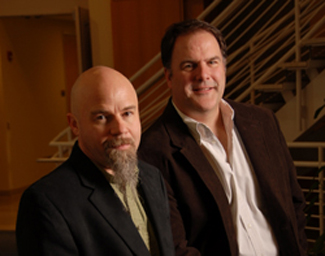CSC News
Virtual Crime Scene
Source: NC State Alumni Magazine*, Volume 83, No. 4, Winter 2011
Tim Buie  works in an office lined with drawings of scary-looking creatures from Savage Skies, a game he designed while working in the video game industry before returning to NC State as an assistant professor of industrial design.
works in an office lined with drawings of scary-looking creatures from Savage Skies, a game he designed while working in the video game industry before returning to NC State as an assistant professor of industrial design.
 works in an office lined with drawings of scary-looking creatures from Savage Skies, a game he designed while working in the video game industry before returning to NC State as an assistant professor of industrial design.
works in an office lined with drawings of scary-looking creatures from Savage Skies, a game he designed while working in the video game industry before returning to NC State as an assistant professor of industrial design.But the avatars he works on these days are anything but fun and games. Buie and other researchers are working on techniques to help forensic scientists virtually recreate a crime scene in 3-D. The system would then allow investigators from different locations to enter the virtual crime scene, complete with tagged evidence, without leaving their offices.
“It will allow investigators from around the country—or around the world—to collaborate and discuss a crime scene in real time,” says Buie, who is working with R. Michael Young (pictured at right in photo), associate professor of engineering.
Here’s how it works: Crime scene investigators, who usually document a scene by taking photographs and writing reports, would bring a 3-D laser scanner that can pick up every data point in the room. The data are then digitized and imported into the program, creating a high-fidelity recreation of the scene.
“It’s a tool trying to bring crime scene investigation into the virtual reality and video game world of the twenty-first century,” says Young. Young said he was surprised to learn that detectives often don’t visit the crime scene, often working instead off photographs and reports. But the tool allows detectives to bring up a scene and look at it in a hologram display. “They can even jump in it and move around,” Young says.
Buie, who works on the visual side of the project, can create avatars to match the height and build of a real witness, perpetrator or victim—he even made one to match an investigator visiting from Fayetteville, N.C. Once in place, the avatars can help investigators re-enact a crime, or check out a witness’ story to see what the witness could have observed from a particular vantage point.
The work, funded by a $1.4 million grant from the National Science Foundation’s Cyber-Enabled Discovery and Innovation Program, is similar to designing a video game, Buie says. “The tools we use are professional-level tools; the workflow is very similar,” he says. “It’s the content that is a little bit different.”
-adcock-
*NC State magazine is a benefit of membership in the NC State Alumni Association. For information on how to join, click here.
Feature Illustration courtesy of The College of Design. Photo by Roger Winstead.
Return To News Homepage